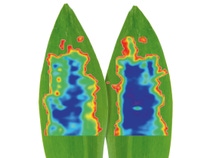Agriculture
AgCelence® for your cereals
Besides providing outstanding disease control, AgCelence® products can protect your yield from tough environmental conditions throughout the growing season.

Increased net photosynthesis and activation of nitrate reductase resulted in greener plants and higher yields. Better stress management can be achieved in drought stress situations. These and further effects have been evaluated by BASF and external scientists. The results of these evaluations have been documented and are widely available. Find some of them here.
Agronomists and growers throughout the world have reported AgCelence® benefits under various agronomic systems and conditions. Regulatory authorities in Europe and other regions approved label claims describing the benefits of AgCelence® in cereals.
AgCelence® effects on your cereals:

Higher yield
Wheat is one of the primary cereals globally. Grown worldwide, wheat is a staple food in North America, Europe and Australia, and is an example of the overall importance of cereals for the proper nutrition of the world’s population. The value of AgCelence® in improving cereal yields begins with a consideration of nitrogen uptake in plants. Nitrogen uptake plays a major role in achieving maximum yields and good quality. Nitrate reductase is the limiting factor for plants when converting soil nitrogen to proteins, which are the building blocks for plant growth. An experiment in Germany demonstrated that nitrate reductase activity increases in cereals after applying AgCelence® products. Thus, more nitrate reductase delivered means a better uptake of nitrate, leading to more plant biomass and higher yields.
Increased stress tolerance
Under drought or other stress conditions, wheat produces fewer tillers, less ears per squaremeter, less grains per ear and reduced grain weight. To ensure its own survival, the plant seeks to complete the life cycle instead of producing more grains. Consequently, yield is reduced. A crop that is more tolerant to stress sustains fewer yield losses under suboptimal conditions.

How does this work?
Under drought conditions plants close their stomata, or openings in the leaf surface, to conserve water, which also reduces photosynthesis. They ripen too fast and full yield potential cannot be reached. Plants treated with AgCelence® products have better stomata-management. Specifically, during drought periods they purposefully open their stomata during the daytime to ensure photosynthesis. This allows AgCelence® treated plants to maximize their yield potential, even under environmentally stressed conditions.
The latest technology involves the use of thermo cameras to observe stressed plants. These cameras are known from energy efficiency analysis of houses. AgCelence® treated plants have better stomata management, which results in controlled transpiration, giving cooler plants and better photosynthesis – which means that you get higher yields.